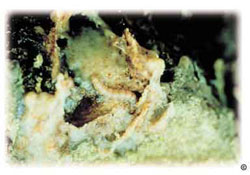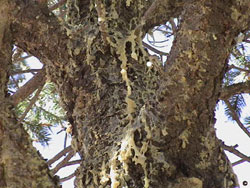What is a piñon pitch mass borer?
The piñon pitch mass borer is a serious pest of piñon trees in landscapes throughout much of Colorado. Though piñon is the main host, ponderosa and occasionally other pines may be infested.
What does a piñon pine borer do to a tree?

Larvae tunnel into the tree’s water conducting vessels, causing large quantities of pinkish pitch to ooze from their entry hole. Damage disfigures large branches and trunks and weakens the tree. Heavily infested branches may even break.
How can I prevent these borers?
Like most borers, the pitch mass borer takes advantage of already weakened trees. In landscapes, over watering and over crowding stress piñons, making them susceptible to an attack. Adjusting irrigation schedules and thinning over crowded areas are the most important control of this borer.

You may try to kill individual borers by inserting a flexible wire into their tunnels; however, larvae can be difficult to find because they often tunnel for several inches under the bark.
Preventive trunk sprays can reduce attacks. Permethrin sprayed on tree trunks and major branches during the late June to August flight period of the adult moth helps prevent additional boring. Two or more treatments per season should be repeated for at least two years on infected trees.
For more information, see the following Colorado State University Extension fact sheet(s).
For more information, see the following Planttalk
Colorado™ script(s).



